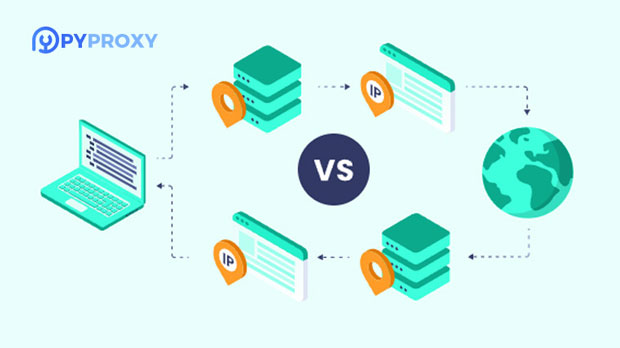In the world of online anonymity and web scraping, proxies play a crucial role in providing a secure and private browsing experience. Among the many proxy services available, Proxy Scrapers and traditional proxy list websites are two popular options. While they both serve the purpose of providing proxy servers, they differ significantly in terms of functionality, ease of use, and reliability. Proxy Scrapers are automated tools that gather proxies from various sources, ensuring a continuous supply of fresh proxies. On the other hand, traditional proxy list websites typically offer static lists of proxies, which may not be as up-to-date or reliable. This article will explore the key differences between Proxy Scrapers and traditional proxy list websites, analyzing their advantages and limitations for users in need of proxies. Understanding Proxy ScrapersA Proxy Scraper is an advanced tool designed to automate the process of collecting proxies from different websites and sources. These scrapers work by scanning the web for publicly available proxy servers and gathering information such as the IP address, port number, type of proxy (HTTP, HTTPS, SOCKS), and other relevant details. The main benefit of using a Proxy Scraper is the ability to access fresh and high-quality proxies in real-time.One of the primary features of Proxy Scrapers is their ability to gather proxies continuously. This means users can always rely on the tool to provide a constantly updated list of proxies, which is crucial for activities like web scraping, data mining, or accessing geo-restricted content. The scrapers are often capable of filtering proxies based on specific criteria, such as country, anonymity level, and speed, which allows users to choose the most suitable proxies for their needs.Moreover, Proxy Scrapers are typically faster and more efficient compared to traditional methods of manually searching for proxies. This is particularly useful for businesses and developers who require large numbers of proxies to conduct web scraping operations or perform other data-intensive tasks.What Are Traditional Proxy List Websites?Traditional proxy list websites, as the name suggests, offer static lists of proxy servers that users can manually browse through and select. These lists are often organized by proxy type, country, and other categories, making it easier for users to find proxies that meet their requirements. While traditional proxy list websites may seem like a straightforward solution, they have several limitations compared to Proxy Scrapers.Typically, traditional proxy lists are not updated in real-time. This means that the proxies listed on these websites may quickly become outdated or unusable. Many of the proxies listed may be blocked, slow, or unreliable, which can significantly hinder the effectiveness of tasks like web scraping or browsing anonymously. Additionally, the proxy lists may not always include detailed information about the proxy’s performance, making it difficult for users to assess the quality of the proxy before using it.Another key drawback of traditional proxy list websites is that they often provide free proxies, which are more likely to be of lower quality compared to paid services. These free proxies may be slow, unreliable, and vulnerable to being blacklisted by websites. Paid proxies, on the other hand, typically offer better performance and security, but they are not always available on traditional proxy list websites.Key Differences Between Proxy Scrapers and Traditional Proxy List Websites1. Automation vs. Manual SelectionThe most significant difference between Proxy Scrapers and traditional proxy list websites lies in the level of automation. Proxy Scrapers are automated tools that gather proxies from various sources in real-time. Users do not need to manually browse through lists or search for proxies. The tool does all the work, providing users with fresh and relevant proxies.In contrast, traditional proxy list websites require users to manually browse through lists of proxies. While these websites may offer convenient categories and filters, the process is still time-consuming and less efficient compared to the automated nature of Proxy Scrapers.2. Proxy Quality and FreshnessProxy Scrapers are generally superior in terms of proxy quality and freshness. Since the scrapers collect proxies from live sources in real-time, the proxies provided are typically more reliable and up-to-date. Users can also filter proxies based on specific requirements, such as speed, location, and anonymity, ensuring that they get the best proxies for their needs.On the other hand, traditional proxy list websites often feature outdated proxies. Many of these proxies may be blocked or unavailable, reducing their effectiveness for web scraping or anonymous browsing. Moreover, these lists may not offer comprehensive information about the proxy’s quality or performance, making it difficult to assess the reliability of the proxies listed.3. Cost and AccessibilityTraditional proxy list websites often offer free proxies, which can be tempting for users on a budget. However, free proxies are typically of lower quality and come with significant limitations, such as slow speeds, reliability issues, and security vulnerabilities. For users who require high-quality proxies, paid services may be more suitable, but these are not always available on traditional proxy list websites.Proxy Scrapers, on the other hand, provide users with access to a broader range of proxies, including paid options that are more reliable and secure. While some Proxy Scrapers may require a subscription or payment for premium features, the value they provide in terms of proxy quality, efficiency, and convenience can justify the cost for many users.4. Use Case and FlexibilityProxy Scrapers are particularly useful for tasks that require large-scale proxy usage, such as web scraping, data mining, and bypassing geo-restrictions. Since these tools continuously gather fresh proxies, they are ideal for users who need a consistent and reliable source of proxies for ongoing projects. Additionally, the ability to filter proxies based on specific criteria makes Proxy Scrapers more flexible for users with specific requirements.Traditional proxy list websites are better suited for users who only need a small number of proxies for occasional use. If you’re only conducting a one-time web scraping operation or need a few proxies for browsing anonymously, a proxy list website might suffice. However, for more extensive tasks or long-term use, Proxy Scrapers offer a higher level of reliability and flexibility.ConclusionIn conclusion, while both Proxy Scrapers and traditional proxy list websites offer proxy services, they differ significantly in terms of functionality, ease of use, and quality. Proxy Scrapers are automated, provide fresh and reliable proxies, and are ideal for users who require large-scale, ongoing proxy usage. Traditional proxy list websites, while offering a convenient starting point for finding proxies, may not provide the same level of automation, quality, or reliability. For users who need consistent, high-quality proxies, Proxy Scrapers are the better option, offering significant advantages over traditional proxy list websites in terms of efficiency, cost, and flexibility.
Jul 04, 2025



































































